This is an AI Free Zone! Text created by Large Language Models is spreading rapidly across the Internet. It's well-written, artificial, frequently inaccurate. If you find a mistake on Spaceweather.com, rest assured it was made by a real human being. | | |
A FAST-GROWING SUNSPOT: Sunspot AR3738 is getting really big. Watch this movie showing how it has grown in the past 5 days. Now almost ten times wider than Earth, the sunspot group is directly facing our planet with a 'beta-gamma' magnetic field that harbors energy for geoeffective solar flares. Solar flare alerts: SMS Text
IS THIS COMET DOOMED? Comet Tsuchinshan-ATLAS (C/2023 A3) is about to fall apart. It's "inevitable," according to a new study by astronomer Zdenek Sekanina. "Evidence suggests that the comet has entered an advanced phase of fragmentation," he writes.
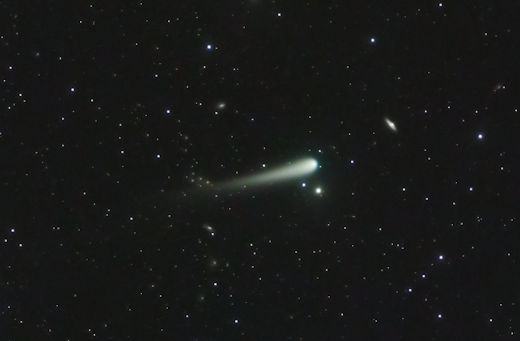
Above: Comet Tsuchinshan-ATLAS photographed by José J. Chambó
If true, this is disappointing news. Discovered in early 2023, the comet appears to be heading for a magnificent close encounter with the sun later this year, perhaps becoming as bright as Venus in October 2024. Instead, it could fall apart before it has a chance to become a naked-eye object.
Sekanina's arguments are threefold: First, the comet has failed to brighten as it approaches the sun. Second, the comet's orbit seems to be affected by a "non-gravitational acceleration." This could happen if, say, inner jets are pushing apart a disintegrating nucleus. Third, the comet's dust tail has an unusually narrow, teardrop shape with a peculiar orientation.
Together, these observations suggest a crumbling comet "in which increasing numbers of fractured refractory solids stay assembled in dark, porous blobs of exotic shape, becoming undetectable as they gradually disperse in space," says Sekanina.
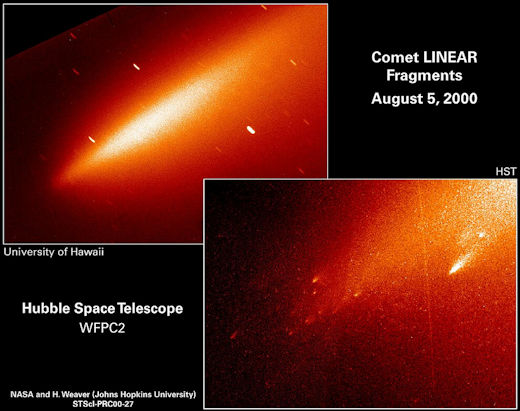
Above: This is what a break-up looks like--Comet LINEAR 24 years ago.
"That is a fascinating paper," says Nick James, director of the Comet Section of the British Astronomical Association. "Sekanina is very well respected in the field, so it carries a lot of weight. To use 'inevitable' in any prediction about a comet may be unwise! But it is definitely a testable theory and another good reason to observe this comet at every opportunity."
In fact, James isn't convinced. In an independent data set, he finds no evidence of non-gravitational accelerations. "This doesn't look like a comet that is fragmenting to me," he says.
We'll soon find out. The comet is brighter than 10th magnitude, well within range of mid-sized backyard telescopes, which means amateur astronomers can monitor the potential break-up. Point your optics here.
Realtime Space Weather Photo Gallery
Free: Spaceweather.com Newsletter
RARE LT. UHURA CHRISTMAS ORNAMENT:You can't buy this on Amazon. The rare Lt. Uhura Christmas Ornament is only available from the Earth to Sky Store. On July 4, 2024, the ornament flew to the stratosphere onboard a cosmic ray research balloon, reaching an altitude of 117,107 feet:
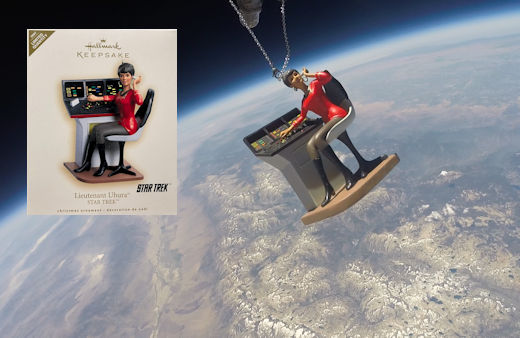
You can have it for $159.95. Sculpted in the likeness of actress Nichelle Nichols, who portrayed Lt. Uhura in the original television series and six Star Trek feature films, the ornamant shows the communications officer on the bridge of the starship Enterprise. It comes with a greeting card showing Uhura in flight, and certifying that she has traveled to the edge of space and back again.
The students of Earth to Sky Calculus are selling space ornaments to support their cosmic ray ballooning program. Don't wait for Christmas--get yours now!
Far Out Gifts: Earth to Sky Store
All sales support hands-on STEM education
Realtime Comet Photo Gallery
Free: Spaceweather.com Newsletter
Realtime Aurora Photo Gallery
Free: Spaceweather.com Newsletter
Realtime Noctilucent Cloud Photo Gallery
Free: Spaceweather.com Newsletter
Every night, a network of
NASA all-sky cameras scans the skies above the United States for meteoritic fireballs. Automated software maintained by NASA's Meteoroid Environment Office calculates their orbits, velocity, penetration depth in Earth's atmosphere and many other characteristics. Daily results are presented here on Spaceweather.com.
On Jul 10, 2024, the network reported 4 fireballs.
(3 sporadics, 1 Northern June Aquilid)
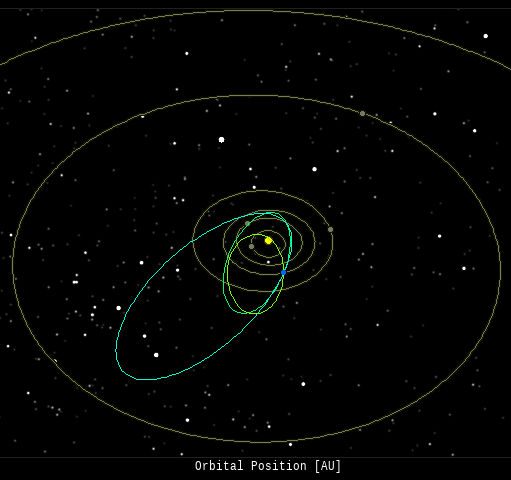
In this diagram of the inner solar system, all of the fireball orbits intersect at a single point--Earth. The orbits are color-coded by velocity, from slow (red) to fast (blue). [Larger image] [movies]
Potentially Hazardous Asteroids (
PHAs) are space rocks larger than approximately 100m that can come closer to Earth than 0.05 AU. None of the known PHAs is on a collision course with our planet, although astronomers are finding
new ones all the time.
On July 10, 2024 there were 2349 potentially hazardous asteroids.
 |
Recent & Upcoming Earth-asteroid encounters: | Asteroid | Date(UT) | Miss Distance | Velocity (km/s) | Diameter (m) |
| 2024 NM1 | 2024-Jul-06 | 1.8 LD | 17.9 | 17 |
| 2024 MT1 | 2024-Jul-08 | 3.9 LD | 18.1 | 78 |
| 2024 NB1 | 2024-Jul-09 | 14.6 LD | 9.7 | 65 |
| 2024 NR1 | 2024-Jul-09 | 16.9 LD | 8.4 | 26 |
| 2024 NA2 | 2024-Jul-09 | 5.9 LD | 4.1 | 33 |
| 2024 ME1 | 2024-Jul-10 | 11.3 LD | 8.4 | 40 |
| 2022 YS5 | 2024-Jul-11 | 11 LD | 5.8 | 38 |
| 2024 NG | 2024-Jul-13 | 9 LD | 7 | 18 |
| 2024 NB2 | 2024-Jul-13 | 10 LD | 13.3 | 33 |
| 2024 BY15 | 2024-Jul-16 | 16.2 LD | 0.7 | 16 |
| 2024 NF | 2024-Jul-17 | 12.6 LD | 20.3 | 71 |
| 2024 MG1 | 2024-Jul-21 | 11.1 LD | 9.3 | 58 |
| 2024 NH | 2024-Jul-23 | 13.1 LD | 5.5 | 29 |
| 2024 LY2 | 2024-Jul-23 | 12 LD | 7.8 | 95 |
| 2011 MW1 | 2024-Jul-25 | 10.1 LD | 8 | 120 |
| 2024 NV1 | 2024-Jul-25 | 14.2 LD | 10.2 | 31 |
| 2024 MH1 | 2024-Jul-26 | 4.7 LD | 5.8 | 27 |
| 2011 AM24 | 2024-Jul-26 | 16.8 LD | 6.2 | 281 |
| 2024 NZ1 | 2024-Jul-28 | 19.6 LD | 12.8 | 55 |
| 523664 | 2024-Jul-28 | 14.9 LD | 23.7 | 680 |
| 2024 NS1 | 2024-Aug-02 | 5.3 LD | 7.6 | 52 |
| 2020 PN1 | 2024-Aug-02 | 18 LD | 5.5 | 29 |
| 2023 HB7 | 2024-Aug-05 | 14.6 LD | 6.1 | 32 |
| 2017 TU1 | 2024-Aug-05 | 10.1 LD | 10.1 | 22 |
| 2024 KH3 | 2024-Aug-10 | 14.6 LD | 11.4 | 196 |
| 2021 GY1 | 2024-Aug-16 | 17.7 LD | 6.3 | 59 |
| 2024 JV33 | 2024-Aug-19 | 12 LD | 11.1 | 212 |
| 2022 BF2 | 2024-Aug-19 | 19.7 LD | 16.4 | 91 |
| 2020 RL | 2024-Aug-27 | 12.2 LD | 8.2 | 34 |
| 2021 RA10 | 2024-Aug-28 | 6.8 LD | 4.9 | 29 |
| 2012 SX49 | 2024-Aug-29 | 11.2 LD | 4.3 | 20 |
| 2016 RJ20 | 2024-Aug-30 | 18.3 LD | 14.8 | 68 |
| 2021 JT | 2024-Sep-01 | 16.4 LD | 8.2 | 12 |
| 2021 RB16 | 2024-Sep-02 | 12.3 LD | 8.4 | 15 |
| 2007 RX8 | 2024-Sep-02 | 18.5 LD | 7 | 44 |
| 2022 SR | 2024-Sep-07 | 9.1 LD | 6.3 | 42 |
Notes: LD means "Lunar Distance." 1 LD = 384,401 km, the distance between Earth and the Moon. 1 LD also equals 0.00256 AU. | | Cosmic Rays in the Atmosphere |
SPACE WEATHER BALLOON DATA: Almost once a week, Spaceweather.com and the students of Earth to Sky Calculus fly space weather balloons to the stratosphere over California. These balloons are equipped with sensors that detect secondary cosmic rays, a form of radiation from space that can penetrate all the way down to Earth's surface. Our monitoring program has been underway without interruption for 7 years, resulting in a unique dataset of in situ atmospheric measurements.
Latest results (July 2022): Atmospheric radiation is decreasing in 2022. Our latest measurements in July 2022 registered a 6-year low:
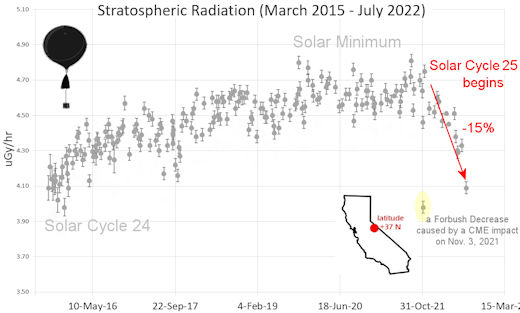
What's going on? Ironically, the radiation drop is caused by increasing solar activity. Solar Cycle 25 has roared to life faster than forecasters expected. The sun's strengthening and increasingly tangled magnetic field repels cosmic rays from deep space. In addition, solar coronal mass ejections (CMEs) sweep aside cosmic rays, causing sharp reductions called "Forbush Decreases." The two effects blend together to bring daily radiation levels down.
.Who cares? Cosmic rays are a surprisingly "down to Earth" form of space weather. They can alter the chemistry of the atmosphere, trigger lightning, and penetrate commercial airplanes. According to a study from the Harvard T.H. Chan school of public health, crews of aircraft have higher rates of cancer than the general population. The researchers listed cosmic rays, irregular sleep habits, and chemical contaminants as leading risk factors. A number of controversial studies (#1, #2, #3, #4) go even further, linking cosmic rays with cardiac arrhythmias and sudden cardiac death.
Technical notes: The radiation sensors onboard our helium balloons detect X-rays and gamma-rays in the energy range 10 keV to 20 MeV. These energies span the range of medical X-ray machines and airport security scanners.
Data points in the graph labeled "Stratospheric Radiation" correspond to the peak of the Regener-Pfotzer maximum, which lies about 67,000 feet above central California. When cosmic rays crash into Earth's atmosphere, they produce a spray of secondary particles that is most intense at the entrance to the stratosphere. Physicists Eric Regener and Georg Pfotzer discovered the maximum using balloons in the 1930s and it is what we are measuring today.
| | The official U.S. government space weather bureau |
| | The first place to look for information about sundogs, pillars, rainbows and related phenomena. |
| | Researchers call it a "Hubble for the sun." SDO is the most advanced solar observatory ever. |
| | 3D views of the sun from NASA's Solar and Terrestrial Relations Observatory |
| | Realtime and archival images of the Sun from SOHO. |
| | information about sunspots based on the latest NOAA/USAF Active Region Summary |
| | current counts of failed and deployed Starlink satellites from Jonathan's Space Page. See also, all satellite statistics. |
| | Authoritative predictions of space junk and satellite re-entries |
| | from the NOAA Space Environment Center |
| | fun to read, but should be taken with a grain of salt! Forecasts looking ahead more than a few days are often wrong. |
| | from the NOAA Space Environment Center |
| | the underlying science of space weather |
 | Got a chipped or cracked windshield that prevents you from seeing space weather events while driving? Get windshield replacement from SR Windows & Glass with free mobile auto glass service anywhere in the Phoenix area. |
 | Marketing yourself on YouTube is hard without real organic views on your videos. You can buy organic YouTube views from and enjoy social boosting that is actually real. Highly recommended! |
 | BestCSGOGambling is the best site for everything related to CSGO gambling on the web |
| | These links help Spaceweather.com stay online. Thank you to our supporters! |
| | | | | | |

